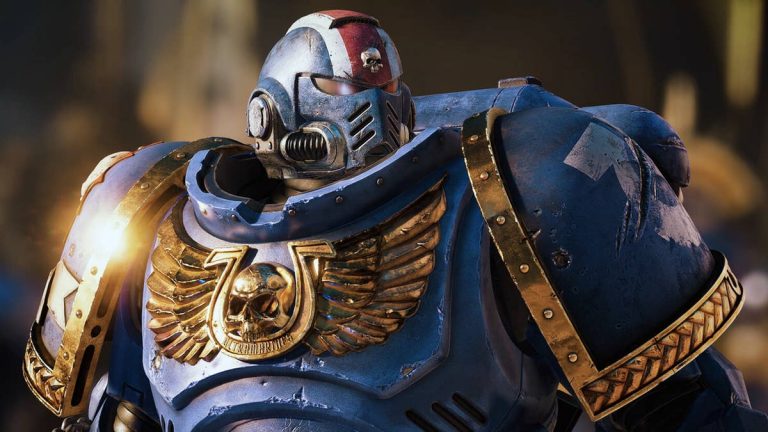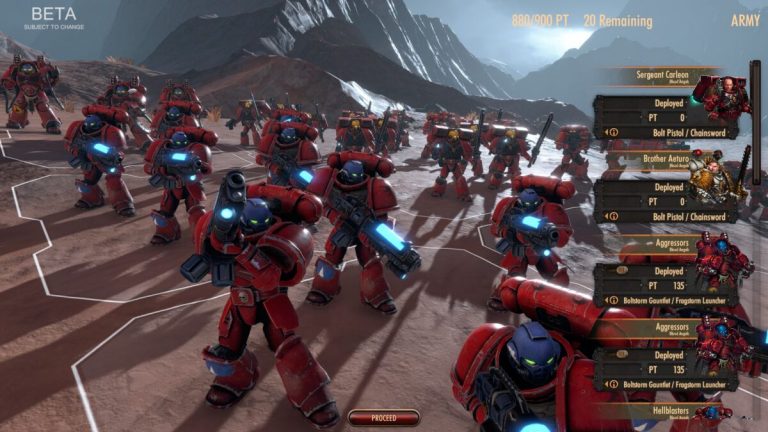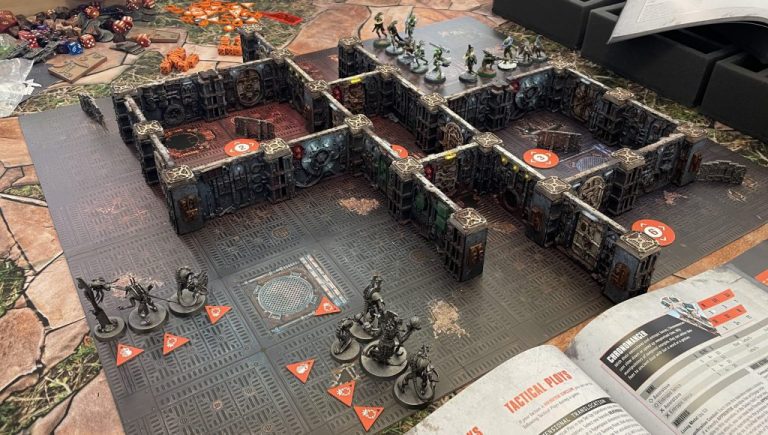Warhammer 40k Games: Advanced Painting Techniques
Welcome to the wonderful world of Warhammer 40k Games, where strategic battles and epic narratives collide! If you’re a fan of this popular tabletop game, then you know that painting your miniatures is an essential part of the experience. But why stop at basic painting techniques when you can take your skills to the next level? In this article, we’ll explore the exciting realm of advanced painting techniques for Warhammer 40k Games, helping you bring your miniature armies to life like never before.
When it comes to Warhammer 40k Games, painting your miniatures is not just about adding a splash of color. It’s an opportunity to showcase your creativity and attention to detail. Advanced painting techniques allow you to elevate your models to a whole new level, making them stand out on the battlefield and impressing your opponents. From realistic weathering effects to intricate freehand designs, there are countless ways to enhance your miniatures and make them truly unique. So, whether you’re a seasoned painter looking to expand your skill set or a beginner eager to dive into the world of advanced techniques, this article will provide you with the guidance and inspiration you need to take your Warhammer 40k painting to the next level.
Looking to take your Warhammer 40k painting skills to the next level? We’ve got you covered with these advanced techniques. From highlighting and shading to weathering and blending, this guide will help you achieve stunning results on your miniatures. Step up your game with step-by-step tutorials, featuring HTML list items, to master each technique. Get ready to bring your Warhammer 40k armies to life like never before. Happy painting!

Warhammer 40k Games: Advanced Painting Techniques
Warhammer 40k is a popular tabletop wargame that involves assembling and painting miniatures to create armies and battle against opponents. For hobbyists and enthusiasts, the painting aspect of Warhammer 40k is just as important as the gameplay itself. Advanced painting techniques can take your miniatures to the next level, adding depth, detail, and realism to your army. In this article, we will explore some advanced painting techniques that will help you enhance your Warhammer 40k miniatures and make them stand out on the tabletop.
1. Layering and Blending
Layering and blending are essential techniques for achieving smooth transitions and gradients on your miniatures. Layering involves applying multiple thin layers of paint on top of each other to build up color and create depth. This technique is particularly effective for highlighting raised areas or creating shadows. Blending, on the other hand, involves seamlessly transitioning between two or more colors by gradually mixing them together. This technique requires patience and practice but can produce stunning results.
When layering and blending, it’s important to thin down your paints with water or a medium to achieve a smoother consistency. Use a small brush and apply thin coats of paint, allowing each layer to dry before adding the next. Start with darker shades and gradually build up to lighter ones. For blending, use a wet-on-wet technique, where you apply wet paint to wet paint, and use a clean brush to blend the colors together. Practice on spare miniatures or paint pots to perfect your layering and blending skills before applying them to your Warhammer 40k army.
Benefits of Layering and Blending:
Layering and blending techniques allow you to add depth, highlights, and shadows to your miniatures, making them look more realistic and visually appealing. These techniques can elevate the overall quality of your painted army and help your miniatures stand out on the tabletop. By mastering layering and blending, you can take your painting skills to the next level and create truly stunning Warhammer 40k miniatures.
Key Points:
- Layering involves applying multiple thin coats of paint to build up color and create depth.
- Blending requires seamlessly transitioning between two or more colors by gradually mixing them together.
- Thin down your paints and apply thin coats for smoother results.
- Practice on spare miniatures or paint pots before applying layering and blending to your army.
2. Wet Blending
Wet blending is a technique that allows you to achieve smooth color transitions and gradients directly on the miniature. Unlike traditional blending, where you mix colors on a palette, wet blending involves manipulating wet paint on the surface of the miniature itself. This technique is particularly useful for creating soft transitions between different colors or blending multiple shades together.
To achieve wet blending, start by applying your base color to the area you want to blend. Then, quickly apply your second color next to it while the base color is still wet. Use a clean brush to gently feather the two colors together, creating a seamless transition. The wetness of the paint makes it easier to manipulate and blend. You can also use a wet brush to further smooth out the transition. This technique requires a bit of speed and precision, as the paint needs to be wet for the blending process to work effectively.
Benefits of Wet Blending:
Wet blending allows for seamless transitions and gradients directly on the miniature, resulting in a smooth and realistic appearance. This technique is particularly effective for creating soft transitions between colors, such as blending different shades on a cloak or blending multiple colors on a gemstone. With wet blending, you have greater control over the blending process and can achieve stunning results with practice.
Key Points:
- Wet blending involves manipulating wet paint on the surface of the miniature.
- Apply the base color and quickly add the second color while the base color is still wet.
- Gently feather the colors together using a clean brush.
- Use a wet brush to further smooth out the transition.
3. Non-Metallic Metal (NMM) Painting
Non-Metallic Metal (NMM) painting is a technique used to create the illusion of metal surfaces without using metallic paints. This technique is commonly used for painting weapons, armor, and other metallic elements on miniatures. By using a combination of light and dark colors, highlights, and shadows, you can achieve a convincing metallic effect.
To paint NMM, start by selecting a color palette that mimics the metal you want to recreate. For example, if you’re painting a sword, you might use shades of gray, white, and black. Begin by applying the base color, then gradually add highlights and shadows to create the illusion of reflection and depth. Use lighter colors for the highlights and darker colors for the shadows. Focus on creating smooth transitions between the different shades to achieve a realistic metallic appearance.
Benefits of NMM Painting:
NMM painting allows you to create convincing metallic effects without relying on metallic paints. This technique gives you more control over the appearance of the metal and allows for greater customization. By mastering NMM painting, you can add a unique and eye-catching element to your Warhammer 40k miniatures.
Key Points:
- NMM painting creates the illusion of metal surfaces without metallic paints.
- Select a color palette that mimics the metal you want to recreate.
- Add highlights and shadows to create the illusion of reflection and depth.
- Create smooth transitions between shades for a realistic metallic appearance.
4. Object Source Lighting (OSL)
Object Source Lighting (OSL) is a technique used to create the illusion of light emanating from a specific object on the miniature. This technique is commonly used for painting glowing effects, such as energy weapons, spellcasting, or glowing eyes. By strategically placing highlights and shadows, you can create the impression of light casting on the surrounding areas.
To paint OSL, start by identifying the light source on your miniature. This could be a weapon, a magical orb, or any other element that emits light. Paint the area around the light source with darker colors to create the illusion of shadow. Then, gradually add lighter colors and highlights closer to the light source to simulate the glow. The key is to create a smooth transition from the darker areas to the lighter ones, ensuring that the light source stands out and casts a realistic glow on the surrounding surfaces.
Benefits of OSL:
OSL painting allows you to add dynamic and eye-catching effects to your miniatures. By creating the illusion of light, you can enhance the overall visual impact of your Warhammer 40k army. OSL painting can make your miniatures stand out on the tabletop and impress your opponents and fellow hobbyists.
Key Points:
- OSL creates the illusion of light emanating from a specific object on the miniature.
- Identify the light source and paint the surrounding areas with darker colors for shadow.
- Add lighter colors and highlights closer to the light source to simulate the glow.
- Create a smooth transition from darker areas to lighter ones for a realistic effect.
Additional Tips for Advanced Painting Techniques
Here are some additional tips to keep in mind as you explore advanced painting techniques for your Warhammer 40k miniatures:
- Practice on spare miniatures or paint pots before applying advanced techniques to your army.
- Experiment with different brushes, paint brands, and techniques to find what works best for you.
- Take your time and be patient. Advanced techniques require practice and attention to detail.
- Study reference images and tutorials to learn from other artists and expand your skills.
- Don’t be afraid to make mistakes. Learning from your mistakes is an essential part of the painting process.
By incorporating advanced painting techniques into your Warhammer 40k hobby, you can elevate the quality of your miniatures and create stunning visual effects. Whether you’re layering and blending, wet blending, painting NMM, or experimenting with OSL, the key is to practice and have fun with your painting journey. Happy painting!
Key Takeaways: Warhammer 40k Games – Advanced Painting Techniques
- 1. Layering different colors creates depth and dimension in your Warhammer 40k miniatures.
- 2. Dry brushing technique helps highlight raised details and adds texture to your painted models.
- 3. Washes can be used to enhance shadows and add weathering effects to your miniatures.
- 4. Edge highlighting is a great way to make your models stand out and add a finishing touch to your paint job.
- 5. Experimenting with advanced techniques like blending and glazing can take your painting skills to the next level.
Frequently Asked Questions
What are some advanced painting techniques for Warhammer 40k games?
When it comes to painting your Warhammer 40k miniatures, there are several advanced techniques you can use to take your models to the next level. One technique is layering, where you build up layers of paint to create depth and highlights on your models. Another technique is dry brushing, which involves lightly brushing a small amount of paint onto raised areas of the model to create texture and highlights. Additionally, you can use washes to add shading and depth to your models, or try out techniques like edge highlighting to make details pop.
To further enhance your painting, you can experiment with techniques like glazing, which involves thinning down paint and applying it in thin layers to create smooth transitions and color blends. Non-metallic metal (NMM) painting is another advanced technique that involves painting metallic surfaces using non-metallic colors to create the illusion of metal. Finally, freehand painting is a challenging but rewarding technique where you can add intricate designs or symbols to your models, allowing you to personalize and customize your Warhammer 40k army.
How can I improve my brush control for advanced painting techniques?
Improving your brush control is essential for executing advanced painting techniques in Warhammer 40k. One way to improve your brush control is to practice regularly by painting on a controlled surface, such as a palette or a spare piece of plastic. This will help you get a feel for the amount of pressure to apply and the consistency of the paint. Additionally, using a brush with a fine tip and a comfortable grip can make a significant difference in your brush control.
Another tip is to vary the size of your brush strokes, from broad strokes for base layers to smaller strokes for details. This will help you achieve more precise and controlled painting. Taking breaks during painting sessions can also help prevent fatigue and maintain steady brush control. Don’t be afraid to experiment and try different techniques to find what works best for you and your painting style.
What are some tips for achieving realistic weathering effects on Warhammer 40k models?
Achieving realistic weathering effects on your Warhammer 40k models can add depth and character to your painting. One tip is to start with a base layer of paint and then gradually build up layers of weathering effects, such as chipping, rust, or dirt. You can use techniques like sponge weathering, where you dab a sponge or sponge brush into paint and lightly stipple it onto the model to create a worn or textured effect.
Another technique is oil washes, where you mix oil paints with a solvent and apply it to recessed areas of the model, allowing the paint to flow and create realistic shadows and grime. You can also experiment with using pigments or powders to create rust or dirt effects on your models. Remember to use reference images or real-life examples of weathered objects for inspiration and to achieve more realistic results.
What are some advanced techniques for painting faces and skin tones in Warhammer 40k?
Painting faces and achieving realistic skin tones can be a challenging but rewarding aspect of Warhammer 40k painting. One advanced technique is to start with a base coat of a neutral skin tone and then gradually build up layers of lighter and darker shades to create depth and highlights. Using glazing techniques can also help create smooth transitions between different areas of the face.
Additionally, paying attention to small details like painting eyebrows, eyes, and lips can bring a face to life. You can use techniques like washes to add shading and depth to facial features, or try out techniques like wet blending to achieve seamless color transitions. Experimenting with different color combinations and studying reference images of real faces can help you improve your painting skills and achieve more realistic results.
How can I add special effects, such as glowing energy or power weapons, to my Warhammer 40k models?
Adding special effects like glowing energy or power weapons can make your Warhammer 40k models stand out on the tabletop. One technique is to start with a base color for the energy or power weapon and then gradually build up layers of lighter shades to create the illusion of glowing or radiating energy.
You can use techniques like wet blending or glazing to create smooth transitions between different colors and add depth to the effect. Adding a thin layer of a translucent paint or ink over the base color can also enhance the glowing effect. Additionally, using a brush with a fine tip or a small detail brush can help you achieve precise and controlled application of the special effects. Don’t be afraid to experiment and try different techniques to find what works best for the desired effect you want to achieve.
7 Tips To INSTANTLY Up Your Miniature Painting Game
Final Summary: Mastering Advanced Painting Techniques in Warhammer 40k Games
So there you have it, aspiring painters and Warhammer 40k enthusiasts! We’ve delved into the world of advanced painting techniques in this article, exploring various methods to take your miniature models to the next level. From layering and dry brushing to highlighting and weathering, these techniques allow you to add depth, realism, and character to your Warhammer 40k creations.
By incorporating these advanced painting techniques, you can truly bring your miniatures to life on the battlefield, capturing the attention of both your opponents and fellow hobbyists. Whether you’re aiming for a battle-worn veteran or a vibrant and eye-catching centerpiece, these techniques provide you with the tools and skills needed to achieve your desired results.
Remember, practice makes perfect. So don’t be discouraged if your first attempts don’t turn out exactly as planned. Embrace the learning process, experiment with different color schemes and techniques, and most importantly, have fun! The Warhammer 40k universe is vast and full of possibilities, and with your newfound painting skills, you’ll be able to create stunning and unique armies that truly stand out on the tabletop.
So grab your brushes, mix your paints, and let your imagination run wild. The world of Warhammer 40k painting awaits, and with these advanced techniques in your arsenal, you’re well on your way to becoming a master of the craft. Happy painting, and may your armies conquer the battlefield with style and finesse!





